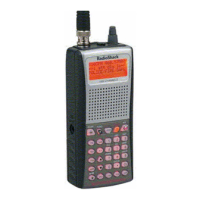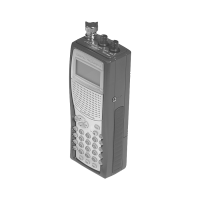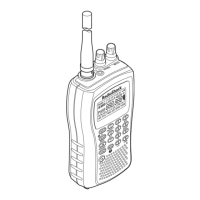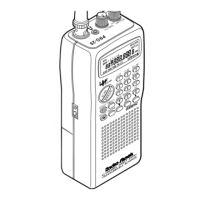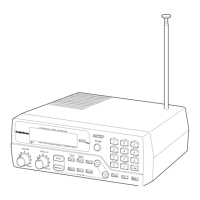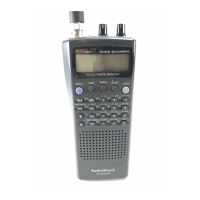Operation
38
blinks
B
BB
B
on the second line for
the lower-end limit frequency.
3. Use the number keys and
./DELAY
to enter the desired
lower-end limit frequency
(including the decimal point).
4. Press
ENTER
to set the
frequency. The cursor moves
to
>
>>
>
. If the entered frequency
is incorrect,
?dlWb_Zý<h[g
?dlWb_Zý<h[g?dlWb_Zý<h[g
?dlWb_Zý<h[g
briefly
appears.
5. Enter your desired higher-end
frequency and press
ENTER
.
6. Rotate
SQUELCH
clockwise
and leave it set to a point just
after the hissing sound stops.
7. Press
SEARCH
to start
searching. When the scanner
finds an active frequency, it
stops searching.
±
You can set Zeromatic on or off by
pressing
FUNC
then
0
. Press
FUNC
then
0
again to reverse the
Zeromatic setting. Whenever this
feature is turned on,
P[hecWj_YýED
P[hecWj_YýEDP[hecWj_YýED
P[hecWj_YýED
briefly appears then
p
pp
p
appears at
the first digit of the second line and
the scanner stops at the correct
frequency. When you turn this
feature off,
p
pp
p
disappears and the
scanner stops when it detects an
active signal. Zeromatic functions
only in search banks 2, 3, 4 and 5.
There are several group banks in
SR2 Police/Fire and SR4 ham
bands. You can turn off or on the
groups by pressing the group
numbers. For example to turn off
&
&&
&
, press
0
.
±
"016'"
±
"
• You can copy and
save a frequency
into a specified
bank, channel, or
priority channel
when the scanner
finds an active
frequency. See
“Using Frequency
Copy” on Page 41
to save the
frequency. The
frequency copy
works only in
search banks 2, 3,
4 and 5.
• While the scanner
is searching, you
can use the seek
search by press-
ing
FUNC
then
7
.
I[[aýED
I[[aýEDI[[aýED
I[[aýED
appears
on the bottom line.
The scanner stops
at an active
frequency for five
seconds and
restarts searching
automatically. The
scanner repeats
this operation.
20-525NEW.fm Page 38 Monday, July 1, 2002 2:58 PM

